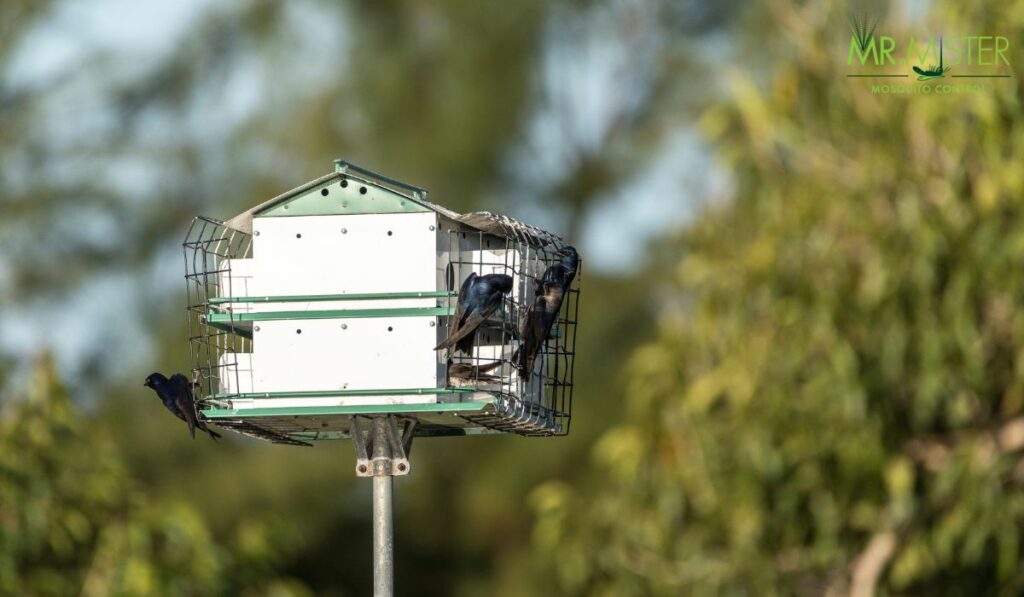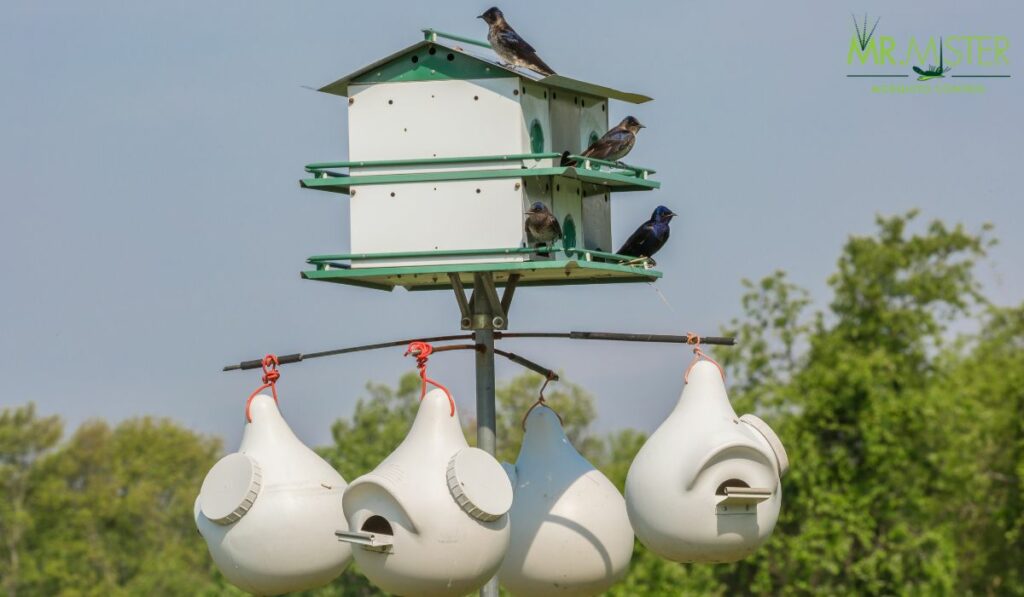Are Purple Martin Houses The Solution For Mosquito Control?
If you’re looking for a natural and effective way to control mosquito populations around your property, purple martin houses can be a valuable tool.
Purple martins are migratory birds known for their voracious appetite for flying insects, including mosquitoes.
By attracting purple martins to nest in your area, you can benefit from their mosquito-consuming habits while enjoying the beauty of these birds.
The Role Of Martin Houses In Mosquito Population Control
Purple martins are skilled aerial insectivores, meaning they catch and consume insects while in flight.
Mosquitoes are a significant part of their diet, and by providing suitable nesting spaces through purple martin houses, you can encourage these birds to reside and breed near your property.
This helps control the local mosquito population naturally, reducing the need for chemical pesticides.
How To Attract Purple Martins?
To attract purple martins, it’s crucial to provide suitable housing and create an inviting environment.
Here are some tips to attract these birds to your property:
- Install Proper Martin Houses: Purple martins prefer multi-compartment houses specifically designed for their nesting needs.Choose a well-constructed martin house with separate compartments for each nesting pair.
- Ideal House Placement: Mount the martin house on a pole or post in an open area, at least 12 to 15 feet high.Ensure the entrance holes are facing open spaces, away from trees or buildings, to prevent predation and interference from other bird species.
- Proper House Maintenance: Clean and maintain the martin house annually before their arrival.Remove old nests, inspect for any damage, and make necessary repairs to ensure a safe and welcoming environment.
- Offer Additional Amenities: Provide water sources, such as birdbaths or small shallow pools, and place them near the martin house to attract insects and provide hydration for the birds.
How Many Mosquitoes Do Purple Martins Eat Per Day?
The number of mosquitoes purple martins consume per day can vary based on factors such as availability and abundance of insects, weather conditions, and the number of nesting pairs present.
On average, a single purple martin can consume hundreds of mosquitoes and other flying insects each day during the breeding season.
Common Myths And Misconceptions About Martin Houses To Control Mosquitoes
There are several myths and misconceptions surrounding purple martin houses and their effectiveness in mosquito control.
Let’s debunk some of them:
- Myth 1: Purple martins eat only mosquitoes: While mosquitoes are a significant part of their diet, purple martins also consume other flying insects, including flies, moths, beetles, and more.
- Myth 2: Purple martins can completely eliminate mosquito populations: While purple martins can help reduce mosquito numbers in the immediate vicinity, they alone cannot eradicate mosquitoes entirely. Other mosquito control measures may be necessary for comprehensive control.
Get Rid Of Your Mosquito Problems With Purple Martins
By attracting purple martins to nest in your area, you can create a win-win situation. Enjoy the mesmerizing sights and sounds of these birds while they help control mosquito populations naturally. Remember to provide suitable housing, maintain the martin house properly, and create an inviting environment to attract and support purple martins in your quest for mosquito control.
Conclusion
In conclusion, purple martin houses are an effective and natural way to control mosquito populations around your property. By attracting these insect-eating birds, you can enjoy their mosquito-consuming habits while creating a win-win situation for both you and the purple martins. Remember to provide suitable housing and a welcoming environment to attract these helpful birds.
FAQs
What is the best placement for a Martin house?
The best placement for a martin house is in an open area, at least 12 to 15 feet high, facing open spaces. Avoid placing the house near trees or buildings that may provide perching spots for predators or attract competing bird species.
Do martin birds eat mosquitoes?
Yes, purple martins are known to eat mosquitoes. They are skilled aerial insectivores and consume a variety of flying insects, including mosquitoes, flies, moths, and more.
Are purple martins aggressive?
Purple martins are generally not aggressive towards humans. However, they can display territorial behavior towards other bird species or intruders near their nesting site. It’s best to maintain a respectful distance and avoid interfering with their nests.
Do purple martins return to the same nest every year?
Purple martins typically return to the general area where they nested in previous years, but they may not use the exact same nest. They have a strong site fidelity and will often return to familiar locations to breed and raise their young.
How far should a Martin house be from the house?
Place martin houses at least 30 to 40 feet away from your house to minimize any potential issues with noise, droppings, or other concerns associated with nesting birds.
How high should a Martin house be off the ground?
A martin house should be mounted on a pole or post at a height of at least 12 to 15 feet above the ground. This height helps provide security and protection for the nesting birds.
Should you clean out Martin houses every year?
Yes, it is essential to clean out martin houses annually, preferably before their return in the spring. Remove old nests, debris, and inspect the house for any damage. This ensures a clean and safe environment for the birds.
When should I put up a new Purple Martin house?
It is best to put up a new purple martin house before their arrival in your area. The timing may vary based on your region, but generally, early spring, before the martins return from migration, is a suitable time to install the house.
When should I take down my Purple Martin house?
You can take down your purple martin house after the nesting season is over and the birds have migrated. This usually occurs in late summer or early fall. Ensure the house is cleaned and stored properly until the following spring.
How do I attract martins to my yard?
To attract martins to your yard, provide suitable housing, such as multi-compartment martin houses. Mount the houses in open areas, maintain proper house hygiene, offer a source of water, and create an inviting environment by minimizing potential disturbances and providing ample flying insects.
What birds will live in a martin house?
While purple martins are the primary tenants of martin houses, other bird species, such as tree swallows or house sparrows, may occasionally occupy unoccupied compartments. Implementing appropriate measures, such as using predator guards and monitoring the house, can help deter unwanted species.
How many purple martin houses do I need?
You can start with one well-constructed martin house with multiple compartments. As your martin population grows, you may consider expanding by adding additional houses to accommodate more nesting pairs. It’s important to provide enough space to avoid overcrowding and territorial conflicts.
Where do Purple Martins go at night?
Purple martins roost communally in large groups called roosts. They often gather in trees, reed beds, or other suitable roosting sites near water bodies. These communal roosts provide safety and protection during the night.
What color should a Purple Martin house be?
The color of a purple martin house is not critical to attracting martins. Traditional white, light gray, or natural wood colors are commonly used. Focus on providing appropriate housing and maintaining a suitable environment rather than the color of the house.
How far apart do you put Purple Martin houses?
If you have multiple martin houses, it’s best to space them at least 30 to 40 feet apart. This spacing helps reduce territorial disputes between neighboring nesting pairs and provides sufficient foraging areas for each group.
What are purple martins scared of?
Purple martins are wary of potential threats, including predators such as owls, hawks, or snakes. Providing predator guards, such as pole baffles or nest cavity restrictors, can help deter unwanted visitors and protect the nesting martins.
How do you keep sparrows out of a Purple Martin house?
To deter house sparrows from occupying martin houses, use entrance hole restrictors specifically designed for purple martins. These restrictors allow martins to enter while preventing sparrows from accessing the nesting compartments.
How long do purple martins live?
Purple martins have an average lifespan of about 6 to 8 years. However, some individuals can live up to 12 years or more under favorable conditions.
Should purple martin houses have perches?
Purple martin houses do not require perches. In fact, perches can provide perching spots for predators or unwanted bird species. The absence of perches in martin houses can enhance the safety and security of the nesting martins.
Should the inside of a Purple Martin house be painted?
It is not necessary to paint the inside of a purple martin house. Leaving the interior unpainted allows for a more natural and suitable nesting environment. Ensure the house is constructed of bird-safe materials without any harmful chemicals or toxins.
Why did my purple martins leave?
Several factors can influence purple martins leaving their nesting site. It could be due to competition with other bird species, lack of suitable food sources, disturbance or interference near the nesting area, unfavorable weather conditions, or insufficient nesting space. Assessing these factors can help address any issues and encourage martins to return in the future.
* Schedule a Free Mosquito Control Consultation – 404-941-0720 *
* Guaranteed Results * 100% Biodegradable * Locally Owned







